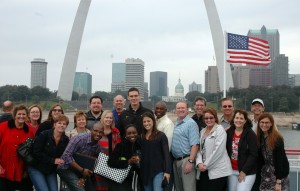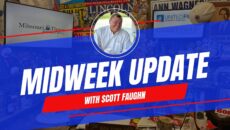ST. LOUIS, MO – What do a magazine publisher, Habitat for Humanity director, and Vice President of DePaul Hospital have in common? Not a whole lot and that’s the point.

These people and more are part of Leadership St. Louis. Leadership St. Louis is a yearlong program promoting leadership in the St. Louis area. It also provides networking.
“I’ve been able to establish budding friendships with people who may not think like me,” said Susan Kidder, Executive Director of Safe Connections. “Different people view things from different lenses.”
The current classmates of Leadership St. Louis and a vast network of alumni were nominated and accepted particularly for diverse backgrounds. Marketing and Communications Director for FOCUS St. Louis, Courtney Mueller, said the goal is to put business leaders, non-profit directors, and civic leaders together. Although influential in their own circles, these people had not had a chance to interact.
“You kind of live in your own silo,” said Antonio Byrd, Contract Compliance Officer for the City of St. Louis Department of Social Services.
The monthly classes are designed to break the ice. They start out somewhat slowly, the first few months taking students through different pieces of infrastructure in the city. The breadth of the river port system surprised Byrd and Jacinta Witherspoon, Director of Resource Development for Habitat for Humanity Saint Louis, even though they had both grown up in the St. Louis area.
Jay Moore, Vice President of Medical Affairs for DePaul Health Center, said learning about the problems facing the city’s sewer system was an eye-opening experience.
“The first step is understanding,” Moore said. “It’s tough to fix anything if you don’t know what the problems are.”
Leaders have an opportunity to share their own experiences within the scope of their own expertise. The group recently visited the Capitol. Rep. Vicki Englund, D-St. Louis, is an alumna of the program and was a part-time guide for the current class. She took part in the program and relished the opportunity to show the inter-workings of Jefferson City.
“Everybody asks, ‘Why aren’t you doing these things?’” Englund said. “I tell them, ‘I agree with you but it’s not that easy.”
Leadership St. Louis takes a whole weekend to cover poverty as an issue; this is where Byrd could step up and share his work. Byrd is responsible for organizing programs to combat homelessness in St. Louis. As an example, the BEACH Project provided 112 of 138 people identified as chronically homeless with rapid rehousing.
“We have the ability to come up with pie in the sky ideas and be successful,” Byrd said.
Byrd also shared his own experiences. He is suited to work with the homeless because he lived out his car for years following high school.
“Going through the poverty class made me appreciate all the people who helped me along the way,” he said.
Just as Englund had misconceptions to clarify, Byrd also took the opportunity. He said many of the people who beg for change are within a few blocks of where they can receive services.
Witherspoon cleared up misconceptions about Habitat Saint Louis.
“A lot of people think Habitat is getting money from the national organization,” she said. “People think it’s just raining money at Habitat.”
The class that stands out for these leaders is the weekend about race. That particular class takes place directly in the middle of the program. It details how segregation enacted in the early 1900s still affects life in the city. It also allows classmates to engage in conversations they may have never had before.
“I never had a conversation with a black guy to ask what it’s like to be black,” Moore said.
Alive Magazine founder and editor Kelly Hamilton also used this as the format to speak out to his fellow classmates, despite not sharing much in the other class periods. With the topic of discrimination up for debate, he disclosed that he used to be a woman and that being transgender opens him up to discrimination.
“They see me as this white guy,” Hamilton said. “I felt like I needed to offer my perspective.”
It’s these types of revelations that bring the participants in Leadership St. Louis closer together. That intimacy is already fostering partnerships on joint projects.
“I don’t think Leadership St. Louis exists to solve problems; it’s about learning about everyone else’s experiences,” Moore said. “They don’t expect us to come out with a master plan.”
A master plan to fix all of St. Louis’ problems may not be in the works, but Leadership St. Louis put together a combination of different people that can affect real change.
“If we continue groups like Leadership St. Louis, St. Louis will be one of those great cities people want to go to,” Byrd said.




